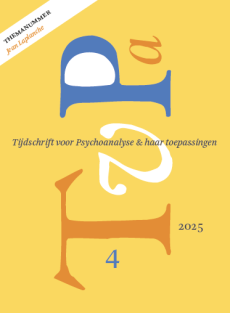Representeren de Afweerfunctieschaal (DSM-IV) en de Defense Style Questionnaire (DSQ-42) een hiërarchie van afweermechanismen? Een onderzoek onder experts
Summary
Twenty definitions of defense mechanisms from the Defensive Functioning Scale (DSM-IV, Axis VI), with one definition added for somatization, and also the items of the Defense Style Questionnaire (DSQ-42), a Dutch version of the DSQ-40 (Andrews e.a. 1993), including two new items concerning the defense mechanism of repression, were judged by 279 Dutch psychoanalysts and psychoanalytical psychotherapists. Questions concerned the correct classification of items of the DSQ-42 in terms of defense mechanisms (Axis-VI, DSM-IV) and the rating of maturity of definitions and items. Of the items, 81% were correctly classified. Classical Multidimensional Scaling for ordinal data yielded a onedimensional structure for both definitions and items. With some exceptions, mainly relating to the five immature scales, the ranking of definitions was in accordance with DSM-IV. The ranking of items did not correspond accurately with the ranking of definitions. On this basis, weights were assigned to the mean scores of the items. From this, separate mean scores can be calculated for adaptive and disadaptive items. This method circumvents the problematic assumption of a necessary relationship between items and definitions, both with respect to the operationalization of defense mechanisms and to the maturity of defenses, and represents a reasonable alternative to the usual division in immature, neurotic and mature scales.
Literatuur
- Andrews, G., Chr. Pollock en G. Stewart (1989), The determination of defense style by questionnaire. Archives of General Psychiatry 46, p.455-460.
- Andrews, G., M. Singh en M. Bond (1993), The Defense Style Questionnaire. Journal of Nervous and Mental Disease 181, p. 246-256.
- APA (American Psychiatric Association) (1994), Diagnostic and Statistical Manual of Mental Disorders, vierde editie (DSM-IV). The Americar Psychiatric Association, Washington.
- Brenner, C. (1981), Defense and defense mechanisms. Psychoanalytic Quarterly 50, p. 557-569.
- Freud, A. (1966), The Ego and the Mechanisms of Defense. International Universities Press, New York (oorspronkelijke publicatie 1937).
- Freud, S. (1937). Die endliche und die unendliche Analyse. Imago, Londen (1952) (Gesammelte Werke XVI, p. 59-99).
- Kruskal, J.B. (1964a), Multidimensional scaling by optimizing goodness of fit to a nonmetric hypothesis. Psychometrika 29, p. 1-27.
- Kruskal, J.B. (1964b). Nonmetric multidimensional scaling: A numerical method. Psychometrika 29, p. 115-129.
- Laplanche, J. en J.-B. Pontalis (1973), The language of Psychoanalysis. The Hogarth Press, Londen.
- Perry, J.Chr. en M.E. Kardos (1995), A review of the defense mechanism rating scales. In: H.R. Conte en R. Plutchik (red.), Ego Defenses. Theory and Measurement. Wiley, New York, p. 283-299.
- Spijker, A. van ’t, H.L. Van en R.W. Trijsburg (1994), Structuur en validiteit van de Defense Style Questionnaire-42. Erasmus Universiteit, Instituut Medische Psychologie en Psychotherapie, Rotterdam (ongepubliceerd manuscript).
- Takane, Y., F.W. Young en J. de Leeuw (1977), Nonmetric individual differences. Multidimensional scaling: an alternating least squares method with optimal scaling features. Psychometrika 42, 7-67.
- Tilburg, W van (1997), De afweerfunctieschaal in klinisch-theoretisch perspectief. Lezing gehouden op de studiedag ‘Afweer’ (De afweerfunctieschaal in de DSM-IV/ Afweeronderzoek), Rotterdam, 26 september 1997.
- Trijsburg, R.W. (1996), Leeranalyse verplicht voor psychoanalytisch psychotherapeuten? Een onderzoek naar opvattingen over en haalbaarheid van de voor het lidmaatschap van de Nederlandse vereniging voor Psychoanalyse verplichte leeranalyse. Tijdschrift voor Psychoanalyse 2, p. 215-230.
- Trijsburg R.W., H.J. Duivenvoorden en D.L. Stronks e.a. (1994), Leertherapie in Nederland. Tijdschrift voor Psychotherapie 20, p. 2-30.
- Vaillant, G.E. (1971), Theoretical hierarchy of adaptive ego mechanisms. Archives of General Psychiatry 24, p. 107-118.
- Vaillant, G.E. (1984), The disadvantages of DSM-III outweigh its advantages. American Journal of Psychiatry 141, p. 542-545.
- Vaillant, G.E. (red.) (1992), Ego Mechanisms of Defense: A Guide for Clinicians and Researchers. American Psychiatric Press, Washington.
- Vaillant, G.E., M. Bond en C.O. Vaillant (1986), An empirically validated hierarchy of defense mechanisms. Archives of General Psychiatry 43, p. 786-794.
- Van, H.L., A. van ’t Spijker en R.W. Trijsburg (1997), Diagnostiek van afweermechanismen. Tijdschrift voor Psychiatrie 39, p. 11-23.
 © 2009-2025 Uitgeverij Boom Amsterdam
© 2009-2025 Uitgeverij Boom Amsterdam
ISSN 1382-516x
De artikelen uit de (online)tijdschriften van Uitgeverij Boom zijn auteursrechtelijk beschermd. U kunt er natuurlijk uit citeren (voorzien van een bronvermelding) maar voor reproductie in welke vorm dan ook moet toestemming aan de uitgever worden gevraagd:
Behoudens de in of krachtens de Auteurswet van 1912 gestelde uitzonderingen mag niets uit deze uitgave worden verveelvoudigd, opgeslagen in een geautomatiseerd gegevensbestand, of openbaar gemaakt, in enige vorm of op enige wijze, hetzij elektronisch, mechanisch door fotokopieën, opnamen of enig andere manier, zonder voorafgaande schriftelijke toestemming van de uitgever.
Voor zover het maken van kopieën uit deze uitgave is toegestaan op grond van artikelen 16h t/m 16m Auteurswet 1912 jo. Besluit van 27 november 2002, Stb 575, dient men de daarvoor wettelijk verschuldigde vergoeding te voldoen aan de Stichting Reprorecht te Hoofddorp (postbus 3060, 2130 KB, www.reprorecht.nl) of contact op te nemen met de uitgever voor het treffen van een rechtstreekse regeling in de zin van art. 16l, vijfde lid, Auteurswet 1912.
Voor het overnemen van gedeelte(n) uit deze uitgave in bloemlezingen, readers en andere compilatiewerken (artikel 16, Auteurswet 1912) kan men zich wenden tot de Stichting PRO (Stichting Publicatie- en Reproductierechten, postbus 3060, 2130 KB Hoofddorp, www.cedar.nl/pro).
No part of this book may be reproduced in any way whatsoever without the written permission of the publisher.
Nieuwsbrief Boom Psychologie
Meld u nu aan en ontvang maandelijks de Boom Psychologie nieuwsbrief met aantrekkelijke aanbiedingen en de nieuwe uitgaven.
Aanmelden


